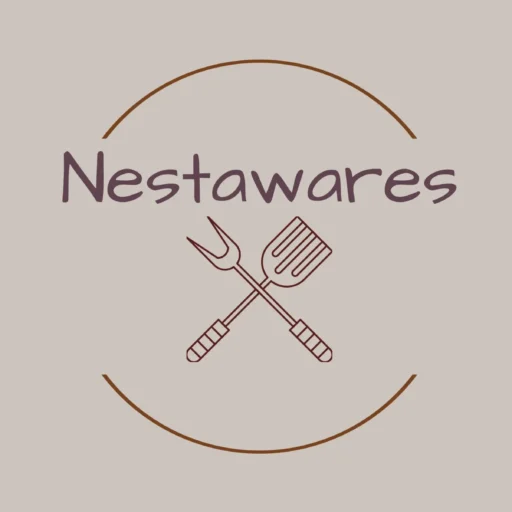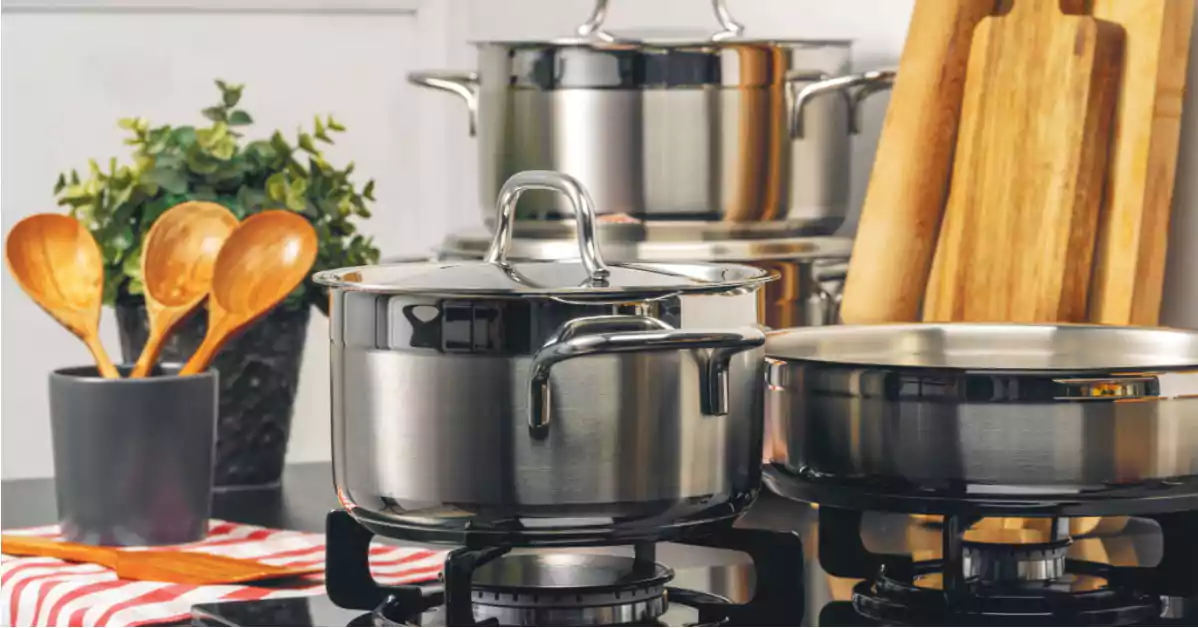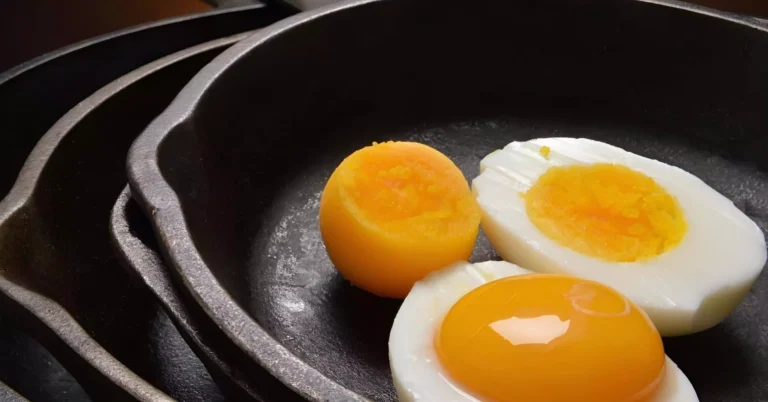A Quick Buying Guide For You
What do we need to look for before investing in a good cookware set?
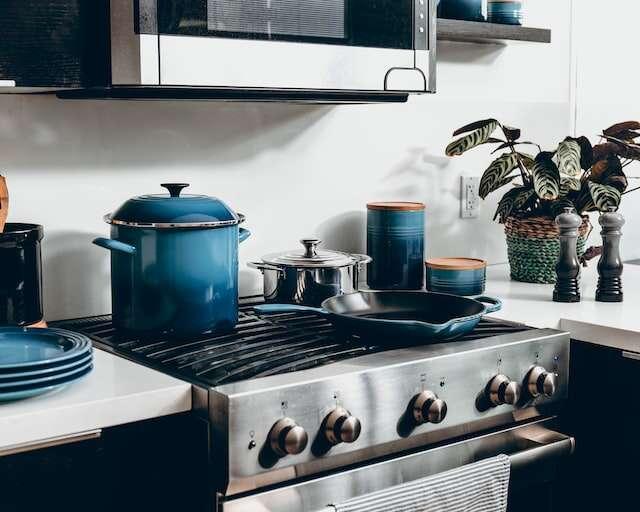
- Heat conduction
The metals used in the construction of your pots and pans should be good conductors of heat.
Not only does that help in effective heat retention but it’s that specific property of a metal that is able to smoothly transfer heat from the source to the vessel without taking much time at all.
Vessels made from conducting metals like aluminum, steel, copper, silver and brass distribute heat evenly without hot spots. And are counted among the best materials for making cookware. - Durability of build
Making cookware out of heat conductive metals doesn’t ensure tough and long-lasting kitchenware.
If they are made from thin sheets of aluminum or are not constructed with layered metals, they turn out to be very fragile and you’ll be looking for new equipment in no time.
I would ask my readers to make sure that the build material is thick and preferably, hard-anodized.
Read what ‘hard-anodized’ means here. - Warp resistance
Due to the high heat of stoves combined with the pans’ inability to respond adequately to temperature changes – there occurs something called warping.
Pans often get warped if they are heated or cooled down too fast and this results in the metal twisting and bending out of shape.
You can take certain precautions to prevent this from happening of course. Like refraining from rinsing hot pans in cold water or placing a bowl from the refrigerator directly into a high flame.
But it’s also better to pick out your kitchen contraptions that are not made from softer metals or have thin construction.
Metals like copper and some kinds of very thin aluminum are more likely to warp than others so keep that in mind while looking for products. - Heat responsive
Heat responsiveness is also another factor to look at while selecting your products.
The more effective they are in quickly responding to generated heat, the less time it’ll take to cook your meals. - Safety
Safety is a given in almost every appliance you buy, be it for the kitchen or anywhere else.
But since you’ll be exposed more to heat and maybe fuel explosions if you’re using gas stoves, it’s important to not only take precautions around the kitchen to prevent accidents but also get products that are built with safety needs in mind.
Do ensure that your cookware is made from non-toxic materials that do not leach harmful chemicals while you cook your food.
They should also be non-reactive to acidic and alkaline ingredients so that you don’t have to ingest elements like copper and iron into your body.
Chemical elements often get picked up during sautéing or searing and not all of them are safe for your health. They also add a metallic taste to the food.
So I would recommend using enameled or seasoned woks, and nonstick cookware that is PFOA and PTFE-free. - Convenient Design
The design of pots and pans is integral to working efficiently in the kitchen as kitchen supplies that are too heavy or too uncomfortable to handle will ultimately result in them being thrown out in due time.
Handles should be designed to help the user have a good grasp of the pots or pans.
Lids should be shatterproof and fit well over the gadgets.
The average weight of the products should be just right to not cause any inconvenience while holding or moving around.
These are just a few considerations one should be aware of while picking stuff for the kitchen. - Cost effective
We all want products that are value for money. And that is justified. When you spend a few bucks at the market, you want the best product that is available at that price point.
There are several brands that often take advantage of their brand value and overprice products that give little to no value.
There is an option for every person out there that meets their specific requirements all while staying under the budget. You can also check out our list of affordable gas stove-compatible cookware here, if you want.
You must identify which features you need the most in your appliance and which ones you can compromise on.
This will help you in your research for the best product suited for you and keep you from getting blown away by good marketing.
Also, it’s a plus for the environment if you are successful in finding the perfect products for your needs under your budget because that will keep us from contributing more to landfill waste.
Frequently Asked Questions
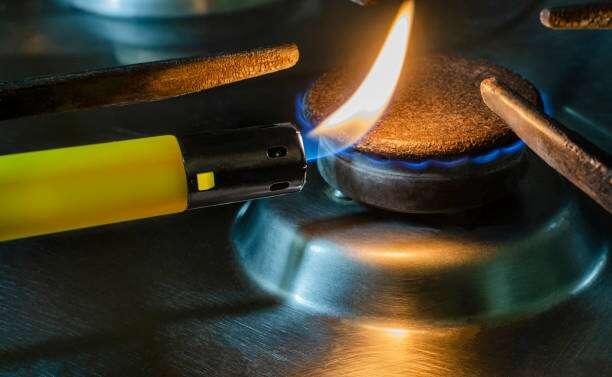
How do gas stovetops work?
Gas stove tops work by sending air and gas through a burner assembly. The gas sent to the cooktop burner, when flows through it – will produce sparks to ignite that gas into continuous flames.
There are two ways to Ignite gas burners. Either you use an electronic ignition system that automatically produces sparks near the burner. Or you can opt to use the more traditional pilot burner to manually ignite the burner.
Once the flames are ignited it will produce enough heat for your cookware to get hot and you’ll be able to cook the content in it.
Gas stove tops come with knobs that you can be manipulated to control the size of the flame. This will impact the heat produced and in turn, will supply the desired amount of heat for your food.
The knobs will regulate the amount of gas flowing through the valves in your stove system.
Make sure you have thermocouple components to counter any combustion issues that may lead to explosions.
Gas stovetops generally operate on natural gas. So you have to have a functioning gas line in your kitchen to cook with one.
This can include having a propane tank on your property or a direct pipe to your kitchen designed to send the appropriate amount of heat required.
The kinds of fuel used as gas for stoves range from Liquefied Petroleum Gas (LPG) to butane and other flammable gases.
How do electric stoves work?
Well, these models don’t even produce flames. Instead, there is a heating element that gets activated when electrical current flow through it. The heat produced in the process is then transferred to the pots and pans placed over it and you can then proceed to cook as usual.
The heating element is basically a flattened spiral coil and there are multiple coils on a single electric stove.
There is a switch, which when turned on will close the circuitry and complete the connection which sends 120 bolts of alternating current through the coils that heat them up in the process.
There are controls for temperature that are used to adjust heat output.
Faulty burners can be replaced separately rather than switching out the entire stove.
Gas stoves vs Electric stoves - Which is better?
Gas stoves are more energy efficient than electronic ones. Stoves that run on fuel require 3x less energy to generate the same amount of heat.
Temperature control is faster and more efficient with gas stovetops. Flames are easier to maintain and you don’t have to worry if the electricity goes out.
Gas is also cheaper which leads to better savings.
What is cladding?
Cladding is the process of layering one material over the other, in order to provide a degree of thermal insulation.
This results in improved heat conductivity and makes the vessels more resistant to warping due to uneven heat distribution.
What type of cladding should I go for?
Depends on the purpose you need it for, of course.
But most people go for 3-ply constructed cookware sets as they are appropriately priced as well as remain heat responsive. Changes in temperature are well received and are effective in transferring heat to the content without much delay.
5-ply construction is even better in terms of endurance to warping.
The thickness makes them more durable but there is a shared problem with both 5-ply and 7-ply cooking equipment.
Sometimes their sheer thickness proves to be a barrier to changes in heat and is slower in heating up altogether.
So, if you want something better than even 3-ply, then go for 5-ply builds which tend to be tougher and provide the best value. They strike a perfect balance between heat retention and performance.
They also won’t be too hard on the pocket like 7-ply constructed kitchenware turns out to be.
What types of cookware are best compatible gas stovetops?
The build material for gas stove compatible kitchenware should ideally be made of three-ply metal.
Usually, stainless steel with a layer of copper and aluminum results in non-reactive and warp resistant equipment that leads to even heat distribution.
Cast iron kitchen equipment is also good but since they are slower to heat up, it’s best to invest in those if you intend to cook meals that require slower cooking techniques.
What types of cookware should we NOT use with gas cooktops?
- Nonstick cookware that is not PFOA or PTFE-free
These types of cookware should be avoided while using gas stoves to cook.
Since the heat produced from a gas flame tends to get hotter faster, there is an increased likelihood of high heat breaking down the PFOA and PTFE substances used in the non-stick build into more toxic chemicals
If you really do need to use nonstick cookware with your gas stove then make sure that they are PFOA, PTFE, lead and cadmium free. - Cookware that is made from pure stone
Cooking gadgets made from pure stone are not recommended for use with gas, electric or any kind of stove top. Mostly because it is just a very bad conductor of heat and takes a lifetime to get heated up and provide even distribution to the contents inside.
Stoneware may be used in some scenarios that include baking as they insulate your cakes and pastries from getting overheated by the oven coil. And of course, they won’t be responsible for any toxins in your food.
But you may not be able to have any good in the first place if you use stoneware to cook. Or at least, you can have your lunch by the end of the week. Just kidding. - Cookware that is extremely thin
It is always better to use cladded kitchenware with a stovetop, as the layered build will protect your wares from uneven heat, warping and as well as provide efficient distribution of heat to your food.
But cheap cookware made from thin and low-quality material is bound to warp and get damaged by the high heat given out by stoves.
Cookware made of thin sheets of aluminum or other alloys from bargain brands will definitely make you lose some bucks than gain some. - Handles made from rubber and plastic
Again, cheap cookware that does not have completely stainless steel handles or aluminum handles should be used with caution with regard to stovetops.
You may get away with using oven mitts for a while because obviously, these will heat up to a point where you’ll end up with scalded palms if you touch them.
But the high heat from stove coils will also melt or burn such handles over time, rendering your pots and pans unusable.
You cannot keep using low flames to cook your food forever, so it’s always better to invest in some quality cookware that does not have such flaws.
What are the benefits of cooking with a gas stove?
- Faster heat generation
- Cheaper fuel costs
- Greater temperature control
- Easier to clean
- More energy efficient
- Easier to maintain flames
What are the disadvantages of cooking with gas stoves?
- Pilot burner not always effective
- Burner flame can be weak occasionally
- Risk of kitchen accidents
- Issues with ventilation if no open outlet nearby
- Grease may accumulate after a few uses
Comparing the Best Cookware Choices for Gas Stovetops
I have compared the best cookware in the market for use with gas stovetops in the below table, based on their top features.
However, if you wish to read more about each of these products – I have posted an article here for your convenience, that talks about each gas stove cookware set’s advantages and drawbacks and whether they would suit your specific culinary needs.
- 3.0 mm thick heavy gauge build made of top-quality aluminum
- Greater thermal mass
- Compatible with all kinds of cooktops
- Durable tri-ply build
- Oven-safe up to 550° F
- Resistant to discoloration
- Non-porous cooking surface
- Hot-spot free quick heating
- Handles stay cool upon touch
- Robust titanium build
- Resilient cooking surface
- Non-reactive
- Sturdy 5-ply construction
- Hotspot-free even heat distribution
- Flared edges for convenient liquid pouring
- Scratch resistant surface
- Stainless steel handles
- Non-toxic
- Tempered glass lids
- Riveted handles cast with silicone
- Practically indestructible
- Outstanding heat retention
- Metal utensil-safe
- Tight fitting lids
- Saucepans come with measurement markings
- Has tapered rims
- Excellent thermal conductivity
- Sturdy cast-iron handles
- Corrosion resistant
- Strong tri-ply construction
- Even heat distribution
- Oven safe and broiler safe up to 600°F
- PFOA, PTFE, PFAS, lead and cadmium free
- Riveted handles made of mirrored stainless steel
- Comes in 6 colors to pick from
